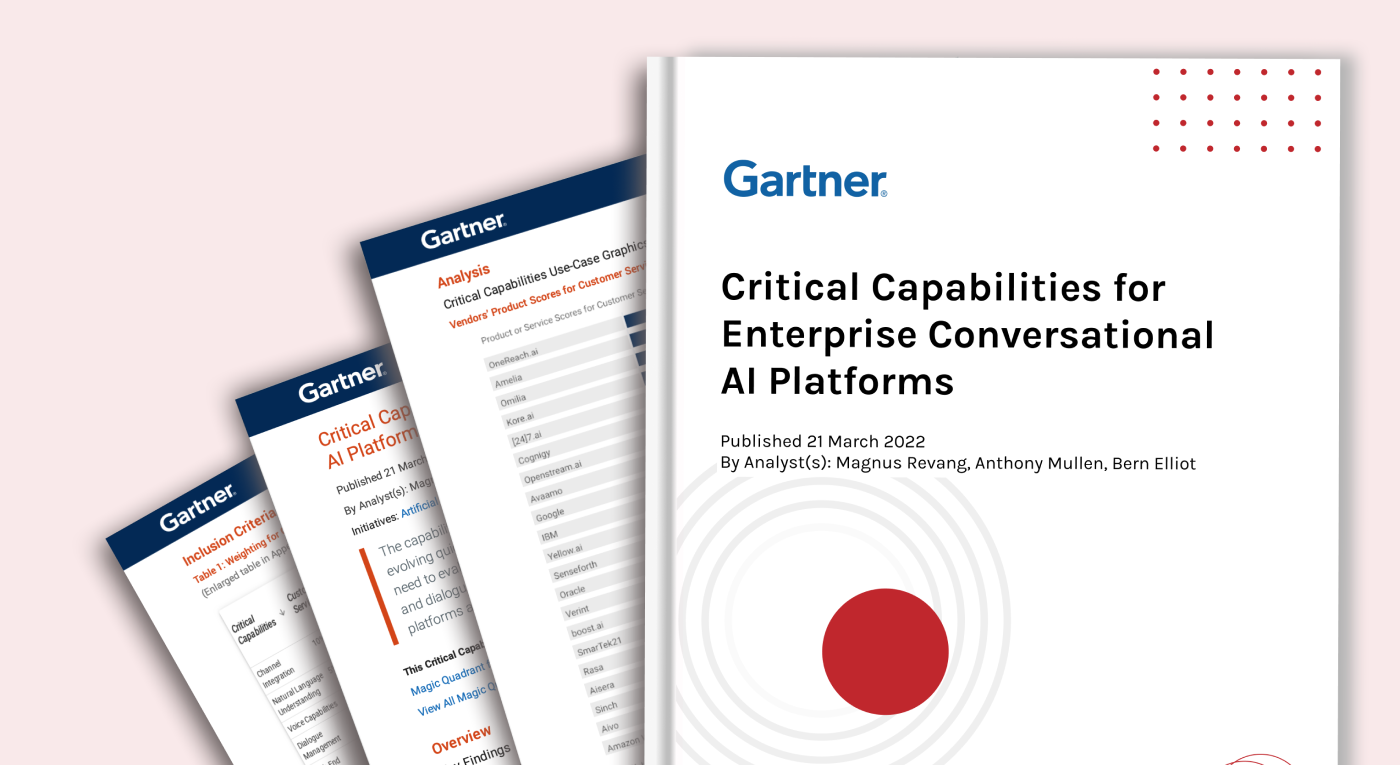The very nature of customer experience is on the precipice of major disruption as the adoption of conversational AI continues to boom. While conversational AI is a broad and confusing term, successful implementation boils down to a holistic strategy for the orchestration of multiple technologies—like NLU/NLP, code-free design, RPA, and machine learning—within an ecosystem that connects all points across an entire organization. When organizations are able to leverage this strategy effectively (achieving a state Gartner calls “hyperautomation”), they gain an almost insurmountable advantage over competitors. While this is clearly of massive concern for business, conversational AI and hyperautomation also create a bold new paradigm for experience design by unleashing a dominant new interface.
Conversation, whether spoken or typed, is an interface that virtually everyone on the planet can use effectively without any advance training. As such we’re entering an age that will come to be dominated by this frictionless (and ubiquitous) UI—one that can enable anybody to employ the problem solving capabilities of advanced technology. These conversations that people have with technology over the coming years are likely to evolve at a rapid pace, as designers begin creating in elevated and accelerated settings—crafting experiences using code-free tools and iterating on them at-will, using data gathered from real-time interactions. In fact, the technology already exists to allow for the creation of conversational experiences using conversational design tools, which is one of the reasons Gartner’s new Critical Capabilities report is pivotal in terms of customer experience.
By Gartner’s 2019 estimation, chatbots will see an increase in adoption rates of more than 100% between now and 2024. Despite advancements in functionality and affordability, last year Gartner VP analyst Anthony Mullen predicted that 90% of today’s chatbots will be discarded by 2023. The dual messages are clear: conversational AI is an inevitability but using it to create rewarding experiences that lead to adoption is extraordinarily difficult.
The Critical Capabilities report was created to help companies evaluate the potential of various platforms to achieve business goals, those platforms’ suitability to individual use cases, and which platforms are flexible enough to fit existing architecture and evolve to handle future use cases. Released as a supplement to their 2022 Magic Quadrant for Enterprise Conversational AI Platforms, Gartner’s Critical Capabilities for Enterprise Conversational AI Platforms report is the first of its kind, focusing squarely on the technological heft of 21 platforms (whittled down from a list of hundreds). In the report, each platform has been given capability scores in areas such as Voice Capabilities, Channel Integration, Bot Orchestration, and Continual Improvement. These scores are then applied across a set of five use cases.
Here, we’ll take a look at the parameters of Gartner’s Customer Service use case and dig into the winning platform’s real-world orchestration of conversational AI that allowed one national retailer to prop up a new call center and cut their inbound call center traffic by 50% in just ten weeks.
The Customer Service Use Case
According to Gartner, the Customer Service use case needs to support “a wide variety of channels, both text- and voice-based, and typically targets a diverse audience.” As such, this use case requires “tooling for the customer service organization and mechanisms to escalate to and involve human agents in operationalization.”
The highest scoring vendor in this use case was OneReach.ai. Their platform, Communication Studio G2 (CSG2), is capable of robust multichannel integration and provides an open system that allows for the integration of the best technology available in the marketplace. To that end, their NLU/NLP engine is actually a system that leverages multiple engines, using whichever one is best suited to individual scenarios (this year, CogX named OneReach.ai best AI Product in NLP for this very system). CSG2 has code-free creation tools that allow organizations to put the design of automation into the hands of the people who understand the tasks being automated (rather than relying on developers). It also incorporates a human-in-the-loop feature that lets a chatbot pass a customer to a human if an automation has stalled out.
This would suggest that the best way to succeed in customer service applications of conversational AI is by incorporating a broad range of channels (touching on every possible way a customer might try to engage with a business) as part of an open system that allows for integration with other vendors. A winning approach also relies on creating automated experiences that take advantage of team members’ knowledge of what kinds of help their customers are generally looking for.
The Winning Platform in Action
For a recent deployment with a national retailer with 1,000+ locations, OneReach.ai was able to create a successful conversational AI strategy from concept to implementation in just ten weeks. An SMS replacement solution forged a new foundation for customer communications, taking over 250 million SMS transmissions per year from their previous vendors (Twilio and Zipwhip). As this retailer expands its digital customer experiences, OneReach.ai will be central to every message sent and received as part of an ongoing effort to evolve those experiences.
OneReach.ai also facilitated the launch of a virtual assistant that has replaced the IVR in a pilot store. It can help customers with hours, location, and intelligent routing—and, using the NLU data generated from the pilot launch, the team at OneReach.ai is refining the experience by identifying new flows, journeys, and FAQs that customers care about.
The conversational experiences that comprise these new automations were created using a highly iterative method wherein solutions are co-created with the people who understand the processes that are being automated. New solutions are propped up quickly and iterated on at a rapid pace until they are delivering the desired customer experience.
“Last January, we put together a demo for [this company] where they could call and text in and go through a whole experience on our platform. It was really fun and they loved all of the interaction,” says Annie Harshberger, a Lead Solution Designer with OneReach.ai. “Once they chose us as their partner, the demo experience helped us understand what they were wanting to build. We’d already co-created solutions with their team and we began involving their call center agents in our process as well. They would call and text into a development version of our bot, and their feedback helped inform the solutions we built. These are the people who will actually be using the solution, so it was critical to have their input.”
This approach can be a jagged pill for organizations who are used to waterfall software builds, but the speed with which OneReach.ai was able to create viable solutions for this retailer is the missing ingredient that will lead to Gartner’s predicted 90% failure rate for conversational AI build outs. With conversational AI poised to take hold across industries, companies of every size and shape will need to rethink their infrastructure and processes, as the new requirements for business demand a more nimble and holistic approach. The way forward, it would seem, will be defined by multiple voices inside of organizations.
“This company’s CTO has been a key leadership partner because we’ve shown him what we can do and the speed at which we can do things and he’s a believer. [They care] deeply about the experiences their customers have and our partnership presented a huge opportunity to take customer service to a new level and streamline the way it looks across 1,000+ stores,” says Andrea Cruz, a Senior Customer Success Manager with OneReach.ai. “Now that more business units have seen the work we’re doing with the call center and SMS, more ideas are coming in from unit leaders. They want OneReach.ai for their internal service desk, for marketing, the list goes on and on.”
This kind of thinking may well represent the future—where flexible open platforms allow businesses to rapidly identify and capitalize on the massive opportunities conversational AI brings while adapting their own operations around the fluctuating nature of the associated technologies. To put that into perspective, OneReach.ai beat out IBM to take over this retailer’s SMS traffic, and stepped over Salesforce to take on their marketing SMS. This is also happening in concert with the marked improvement of experiences people have with conversational AI.
“Even now, there are times you sort of can’t tell it’s not a human,” Gartner analyst Bern Elliot recently told The New York Times. “It’s not as good as you’d like, but it is moving in that direction. And innovation is occurring at a rapid pace.”
Conclusion
OneReach.ai’s win in this use case is credit to a philosophy that has been simmering at the core of the company since its inception (one that’s further validated further by the fact that their platform garnered the highest score in four out of five use cases in the Critical Capabilities report and came in second in the fifth use case). Founder Robb Wilson has spent more than twenty years working with conversational AI and is the author of a forthcoming book from Wiley about putting this technology to work.
In Age of Invisible Machines, he writes, “Implementing a strategy for hyperautomation is a massive undertaking that requires cooperation from every department within your organization. But you’re not helpless in the face of hyperautomation … You can take charge, but first you have to surrender many of the old ways of doing things. Hyperautomating isn’t a space for concrete plans, flexibility is the name of the game, and you need an open platform that gives you control of the tools and software you use when automating experiences.”
If the Inaugural 2022 Gartner Critical Capabilities for Enterprise Conversational AI Platforms report is the marketwide siren it sounds to be, this kind of flexibility will be in high demand moving forward. Consider this welcome news for experience designers, who have been advocating for the holistic implementation of flexible technology for decades now.








